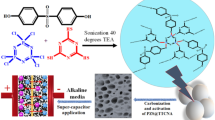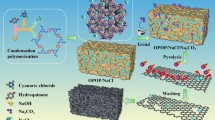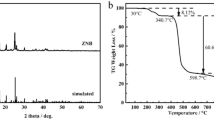Abstract
In this paper, bamboo-like, O-doped carbon tubes with hierarchical pore structure have been fabricated by the direct pyrolysis of dual cross-linked polydivinylbenzene (PDVB) tubes. The bamboo-like, cross-linked PDVB tubes are firstly synthesized by cationic polymerization of divinylbenzene in cyclohexane using BF3/Et2O complex as the initiator. After a secondary cross-linking being imposed by Friedel–Crafts reaction in CCl4 using anhydrous AlCl3 as the catalyst, the obtained dual cross-linked, carboxylic acid functionalized PDVB tubes are directly subjected to pyrolysis, yielding bamboo-like, O-doped porous carbons. The resultant O-doped porous carbon tubes (BCTF-900, pyrolyzed at 900 °C) exhibit a trimodal pore structure (micro-, meso-, and macropores) with a relatively high specific surface area of 595 m2 g−1 and a low total pore volume of 0.37 cm3 g−1. Such bamboo-like carbon tubes display good volumetric capacitive performance (254 F cm−3 at 0.5 A g−1), moderate volumetric energy density (12.9 Wh L−1 at 428 W L−1), and excellent cycling stability (the capacitance retention has remained at 96.9% after 10000 cycles at 2 A g−1). Due to their unique bamboo-like architecture and trimodal pore structure, the PDVB-derived carbon tubes should have widely application prospect.







Similar content being viewed by others
References
Parlett CMA, Wilson K, Lee AF (2013) Hierarchical porous materials: catalytic applications. Chem Soc Rev 42:3876–3893
Zhu C, Li H, Fu S, Lin Y (2016) Highly efficient nonprecious metal catalysts towards oxygen reduction reaction based on three-dimensional porous carbon nanostructures. Chem Soc Rev 45:517–531
Sakaush K, Anton M (2015) Carbon- and nitrogen-based porous solids: a recently emerging class of materials. Bull Chem Soc Jpn 88:386–398
Fang B, Kim JH, Kim M, Yu JS (2009) Ordered hierarchical nanostructured carbon as a highly efficient cathode catalyst support in proton exchange membrane fuel cell. Chem Mater 21:789–796
Park J, Kim H, Sook E, Son I, Han S (2009) Effect of the porous carbon layer in the cathode gas diffusion media on direct methanol fuel cell performances. Int J Hydrogen Energy 34:8257–8262
Paul GS, Kim JH, Kim M-S, Do K, Ko J, Yu JS (2012) Different hierarchical nanostructured carbons as counter electrodes for Cds quantum dot solar cells. ACS Appl Mater Interfaces 4:375–381
Jia R, Chen J, Zhao J, Zheng J, Song C, Li L, Zhu Z (2010) Synthesis of highly nitrogen-doped hollow carbon nanoparticles and their excellent electrocatalytic properties in dye-sensitized solar cells. J Mater Chem 20:10829–10834
Doherty CM, Caruso RA, Smarsly BM, Adelhelm P, Drummond CJ (2009) Hierarchically porous monolithic LiFePO4/carbon composite electrode materials for high power lithium ion batteries. Chem Mater 21:5300–5306
Roberts AD, Li X, Zhang H (2014) Porous carbon spheres and monoliths: morphology control, pore size tuning and their applications as Li-ion battery anode materials. Chem Soc Rev 43:4341–4356
Wang Q, Yan J, Fan Z (2016) Carbon materials for high volumetric performance supercapacitors: design, progress, challenges and opportunities. Energy Environ Sci 9:729–762
Tan Y, Zhang W, Gao Y, Wu J, Tang B (2015) Synthesis of ordered mesoporous carbon nanofiber arrays/nickel–boron amorphous alloy with high electrochemical performance for supercapacitor. J Mater Sci 50:4622–4628. doi:10.1007/s10853-015-9012-2
Aslam Z, Shawabkeh RA, Hussein IA, Al-baghli N (2015) Synthesis of activated carbon from oil fly ash for removal of H2S from gas stream. Appl Surf Sci 327:107–115
Peterson GW, Decoste JB, Fatollahi-Fard F, Britt D (2014) Engineering UiO-66-NH2 for toxic gas removal. Ind Eng Chem Res 53:701–707
Wei G, Miao Y, Zhang C, Yang Z, Liu Z, Tjiu WW, Liu T (2013) Ni-Doped graphene/carbon cryogels and their applications ss versatile sorbents for water purification. ACS Appl Mater Interfaces 5:7584–7591
Sui Z, Meng Q, Zhang X, Ma R, Cao B (2012) Green synthesis of carbon nanotube–graphene hybrid aerogels and their use as versatile agents for water purification. J Mater Chem 22:8767–8771
He Z, Zhang G, Chen Y, **e Y, Zhu T, Guo H, Chen Y (2017) The effect of activation methods on the electrochemical performance of ordered mesoporous carbon for supercapacitor applications. J Mater Sci 52:2422–2434. doi:10.1007/s10853-016-0536-x
Malgras V, Ji Q, Kamachi Y, Mori T, Shieh F-K, Wu KC-W, Ariga K, Yamauchi Y (2015) Templated synthesis for nanoarchitectured porous materials. Bull Chem Soc Jpn 88:1171–1200
Guo B, Wang X, Fulvio PF, Chi M, Mahurin SM, Sun XG, Dai S (2011) Soft-templated mesoporous carbon-carbon nanotube composites for high performance lithium-ion batteries. Adv Mater 23:4661–4666
Huang CH, Doong RA, Gu D, Zhao D (2011) Dual-template synthesis of magnetically-separable hierarchically-ordered porous carbons by catalytic graphitization. Carbon 49:3055–3064
Han FD, Bai YJ, Liu R, Yao B, Qi YX, Lun N, Zhang JX (2011) Template-free synthesis of interconnected hollow carbon nanospheres for high-performance anode material in lithium-ion batteries. Adv Energy Mater 1:798–801
Lee J, Han S, Hyeon T (2004) Synthesis of new nanoporous carbon materials using nanostructured silica materials as templates. J Mater Chem 14:478–486
Loiola AR, da Silva LRD, Cubillas P, Anderson MW (2008) Synthesis and characterization of hierarchical porous materials incorporating a cubic mesoporous phase. J Mater Chem 18:4985–4993
Górka J, Jaroniec M (2011) Hierarchically porous phenolic resin-based carbons obtained by block copolymer-colloidal silica templating and post-synthesis activation with carbon dioxide and water vapor. Carbon 49:154–160
Wan Y, Zhao D (2007) On the controllable soft-templating approach to mesoporous silicates. Chem Rev 107:2821–2860
Carriazo D, Picó F, Gutiérrez MC, Rubio F, Rojo JM, del Monte F (2010) Block-Copolymer assisted synthesis of hierarchical carbon monoliths suitable as supercapacitor electrodes. J Mater Chem 20:773–780
Simmons BA, Li SC, John VT, McPherson GL, Bose A, Zhou WL, He JB (2002) Morphology of US nanocrystals synthesized in a mixed surfactant system. Nano Lett 2:263–268
John VT, Simmons B, McPherson GL, Bose A (2002) Recent developments in materials synthesis in surfactant systems. Curr Opin Colloid Interface Sci 7:288–295
Wang K, Zhang J, **a W, Zou R, Guo J, Gao Z, Yan W, Guo S, Xu Q (2013) Dual templating route to three-dimensional ordered mesoporous carbon nanonetworks: tuning the mesopore type for electrochemical performance optimization. J Mater Chem A 1:1–3
Petkovich ND, Stein A (2013) Controlling macro- and mesostructures with hierarchical porosity through combined hard and soft templating. Chem Soc Rev 42:3721–3739
Zou C, Wu D, Li M, Zeng Q, Xu F, Huang Z, Fu R (2010) Template-free fabrication of hierarchical porous carbon by constructing carbonyl crosslinking bridges between polystyrene chains. J Mater Chem 20:731–735
Zeng Q, Wu D, Zou C, Xu F, Fu R, Li Z, Liang Y, Su D (2010) Template-free fabrication of hierarchical porous carbon based on intra-/inter-sphere crosslinking of monodisperse styrene-divinylbenzene copolymer nanospheres. Chem Commun 46:5927–5929
Li Z, Wu D, Huang X, Ma J, Liu H, Liang Y, Fu R, Matyjaszewski K (2014) Fabrication of novel polymeric and carbonaceous nanoscale networks by the union of self-assembly and hypercrosslinking. Energy Environ Sci 7:3006–3012
Ni W, Liang F, Liu J, Qu X, Zhang C, Li J, Wang Q, Yang Z (2011) Polymer nanotubes toward gelating organic chemicals. Chem Commun 47:4727–4729
Rabek JF, Lucki J (1988) Crosslinking of polystyrene under friedel–crafts conditions in dichloroethane and carbon tetrachloride solvents through the formation of strongly colored polymer–AlCl3–solvent complexes. J Polym Sci Part A Polym Chem 26:2537–2551
Tang Y, Liu L, Wang X, Zhou H, Jia D (2014) High-yield bamboo-like porous carbon nanotubes with high-rate capability as anodes for lithium-ion batteries. RSC Adv 4:44852–44857
Yang Y, Liu L, Tang Y, Zhang Y, Jia D, Kong L (2016) Bamboo-like carbon nanotubes containing sulfur for high performance supercapacitors. Electrochim Acta 191:846–853
Krishnakumar V, Muthunatesan S, Keresztury G, Sundius T (2005) Scaled quantum chemical calculations and FTIR, FT-Raman spectral analysis of 3,4-diamino benzophenone. Spectrochim Acta Part 62:1081–1088
Serbezeanu D, Popa AM, Sava I, Carja ID, Amberg M, Rossi RM, Fortunato G (2015) Design and synthesis of polyimide-gold nanofibers with tunable optical properties. Eur Polym J 64:10–20
Sing KSW, Everett DH, Haul RAW, Moscou L, Pierotti LA, Rouquerol J, Siemieniewska T (1985) International union of pure and applied chemistry physical chemistry division reporting physisorption data for gas/soils systems with special reference to the determination of surface area and porosity. Pure Appl Chem 57:603–619
Puziy AM, Poddubnaya OI, Socha RP, Gurgul J, Wisniewski M (2008) XPS and NMR studies of phosphoric acid activated carbons. Carbon 46:2113–2123
Gao B, Yap PS, Lim TM, Lim TT (2011) Adsorption-photocatalytic degradation of Acid Red 88 by supported TiO2: effect of activated carbon support and aqueous anions. Chem Eng J 171:1098–1107
Li Z, Xu Z, Wang H, Ding J, Zahiri B, Holt CMB, Tan X, Mitlin D (2014) Colossal pseudocapacitance in a high functionality–high surface area carbon anode doubles the energy of an asymmetric supercapacitor. Energy Environ Sci 7:1708–1718
Figueiredo JL, Pereira MFR (2010) The role of surface chemistry in catalysis with carbons. Catal Today 150:2–7
Kubo S, Tan I, White RJ, Antonietti M, Titirici MM (2010) Template synthesis of carbonaceous tubular nanostructures with tunable surface properties. Chem Mater 22:6590–6597
Long C, Jiang L, Wu X, Jiang Y, Yang D, Wang C, Wei T, Fan Z (2015) Facile synthesis of functionalized porous carbon with three-dimensional interconnected pore structure for high volumetric performance supercapacitors. Carbon 93:412–420
Zurich T, Wolf R (2011) True performance metrics in electrochemical energy storage. Science 334:917–918
Zhao B, Liu P, Jiang Y, Pan D, Tao H, Song J, Fang T, Xu W (2012) Supercapacitor performances of thermally reduced graphene oxide. J Power Sources 198:423–427
Du Q, Zheng M, Zhang L, Wang Y, Chen J, Xue L, Dai W, Ji G, Cao J (2010) Preparation of functionalized graphene sheets by a low-temperature thermal exfoliation approach and their electrochemical supercapacitive behaviors. Electrochim Acta 55:3897–3903
Stoeckli F, Centeno TA (2013) Optimization of the characterization of porous carbons for supercapacitors. J Mater Chem A 1:6865–6873
Liu B, Zhou X, Chen H, Liu Y, Li H (2016) Promising porous carbons derived from lotus seedpods with outstanding supercapacitance performance. Electrochim Acta 208:55–63
Peng Z, Zhang D, Yan T, Zhang J, Shi L (2013) Three-dimensional micro/mesoporous carbon composites with carbon nanotube networks for capacitive deionization. Appl Surf Sci 282:965–973
Yang X, Wu D, Chen X, Fu R (2010) Nitrogen-enriched nanocarbons with a 3-D continuous mesopore structure from polyacrylonitrile for supercapacitor application. J Phys Chem C 114:8581–8586
Mi J, Wang XR, Fan RJ, Qu WH, Li WC (2012) Coconut-shell-based porous carbons with a tunable micro/mesopore ratio for high-performance supercapacitors. Energy Fuels 26:5321–5329
Fic K, Lota G, Meller M, Frackowiak E (2012) Novel insight into neutral medium as electrolyte for high-voltage supercapacitors. Energy Environ Sci 5:5842–5850
Bichat MP, Raymundo-Pinero E, Béguin F (2010) High voltage supercapacitor built with seaweed carbons in neutral aqueous electrolyte. Carbon 48:4351–4361
Yan J, Wang Q, Wei T, Fan Z (2014) Recent advances in design and fabrication of electrochemical supercapacitors with high energy densities. Adv Energy Mater 4:157–164
Zhao L, Yu J, Li W, Wang S, Dai C, Wu J, Bai X, Zhi C (2014) Honeycomb porous MnO2 nanofibers assembled from radially grown nanosheets for aqueous supercapacitors with high working voltage and energy density. Nano Energy 4:39–48
Wang DW, Li F, Liu M, Lu GQ, Cheng HM (2008) 3D aperiodic hierarchical porous graphitic carbon material for high-rate electrochemical capacitive energy storage. Angew Chem 47:373–376
Stoller MD, Park S, Zhu Y, An J, Ruoff RS (2008) Graphene-based ultracapacitors. Nano Lett 8:3498–3502
Fang B, Wei YZ, Suzuki K, Kumagai M (2005) Surface modification of carbonaceous materials for EDLCs application. Electrochim Acta 50:3616–3621
Acknowledgements
Financial support from Program for NSFC (51272219), RFDP (20124301110006), and the Construct Program of the Key Discipline in Hunan Province is greatly acknowledged.
Author information
Authors and Affiliations
Corresponding authors
Electronic supplementary material
Below is the link to the electronic supplementary material.
Rights and permissions
About this article
Cite this article
Xu, Z., Liu, Y., Chen, H. et al. Bamboo-like, oxygen-doped carbon tubes with hierarchical pore structure derived from polymer tubes for supercapacitor applications. J Mater Sci 52, 7781–7793 (2017). https://doi.org/10.1007/s10853-017-1064-z
Received:
Accepted:
Published:
Issue Date:
DOI: https://doi.org/10.1007/s10853-017-1064-z




